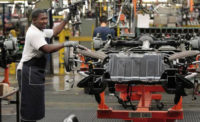Manufacturing Software
Modine Builds Supply Chain Resiliency Through Technology
Software enables company to optimize inventories and prevent shortages.






Necessity is the mother of invention, and in Wisconsin in winter, a major necessity is keeping warm. That reality would eventually lead to the creation of a Fortune 1000 manufacturer.
In 1916, Arthur B. Modine founded Modine Manufacturing Co. in Racine, WI, after receiving a patent for a new radiator for tractors. Later, the company’s radiators would become standard equipment on the Ford Model T.
In 1918, in response to frigid winter temperatures and inadequate heating options on the market, Arthur combined a radiator, a fan and steam pipes to construct a heater to keep his factory workers warm. That product would become the start of the company’s heating business. When he died at the age of 95, Arthur had been granted more than 120 U.S. patents for his heat-transfer innovations.
Today, Modine Manufacturing makes heating, ventilating, and air conditioning equipment; cooling systems for EV batteries and data centers; radiators, air coolers and oil coolers for cars, trucks and heavy equipment; and heat transfer coils for commercial, industrial and refrigeration applications. The company has 38 manufacturing facilities in North America, South America, Europe and Asia and employs some 13,000 people worldwide. In its 2023-24 fiscal year, it tallied total sales of more than $2.4 billion and reported a net profit of over $161 million.
Streamlining Supply Chain Processes
As it grew, Modine faced significant challenges in its supply chain processes. The company’s heavy reliance on manually managing most aspects of its supply chain led to ongoing inefficiencies and hindered overall performance.
The team experienced difficulties in managing shortages due to suboptimal processes and excessive manual efforts, leading to a lag in fulfillment. The company needed to right-size inventory for more efficiency, and the lack of analytics across different sites highlighted a need for more comprehensive and collaborative insights across the supply chain.
Modine specifically identified the ability to optimize materials and manage its supply chain with predictive analytics and prescriptive execution recommendations as vital to digitally transforming its supply chain. To meet these goals, the company implemented LeanDNA, an intelligent supply chain execution platform.
“We need to reduce our reliance on spreadsheets. Is this scalable? Is this sustainable? You must invest in smart learning and decision-making platforms like LeanDNA that can help you be more agile,” says Vatsal Gandhi, executive director of global supply chain at Modine.
The partnership between Modine and LeanDNA successfully addressed chronic part shortages and inconsistent deliveries. It introduced a supplier fulfillment control tower, establishing a structured framework and processes and enhanced communication. This project resulted in tangible and significant improvements, setting up the team to continuously improve and optimize their supply chain.
Modine’s fast-track implementation of LeanDNA was completed within a record time of under two months. Modine’s eagerness to digitize the supply chain execution process has positioned them for strong results that can be built on as the team continuously optimizes with LeanDNA.
Supplier Fulfillment Control Tower
Through the partnership with LeanDNA, Modine developed a structured framework, standard templates, and processes within a Supplier Fulfillment Control Tower. This led to development of a supplier fulfillment team infrastructure, strengthening data quality, integration, and analysis capabilities. The software also brought about improvements in key performance indicators (KPI) and management. Modine can now effectively track and manage key metrics, such as revenue at risk, clear-to-build percentage, past-due items and shortages. By involving different stakeholders, including material managers, buyers, planners and procurement, LeanDNA has facilitated cross-functional collaboration, and the platform has become a central hub for addressing critical material shortages at various levels.
“LeanDNA seamlessly integrates with our ERP system and facilitates enhanced supply chain decision-making at multiple levels of the organization. It not only provides summary dashboards and intelligence to leadership, but it also empowers front-line employees with superior information and diminishes their workload,” said James Dawsey, senior SIOP and demand management leader at Modine.
The supplier fulfillment control tower acted as a catalyst for unified capabilities, processes and systems that fostered better supplier relationship management, clearer supplier communication, more transparent demand planning processes, and business continuity. It also created a platform for on-site supplier assessments, and the development of short-term and long-term improvement plans.
Transforming Supply Chain Performance
The project has resulted in significant, tangible improvements across various aspects of Modine’s supply chain, most notably contributing to enhanced efficiency, reduced shortages, and improved overall operational resilience. The software’s diverse functionalities have empowered Modine to proactively address challenges and drive continuous improvement initiatives. Modine factories that have implemented the LeanDNA platform have seen 40 percent reduction in material shortages and 50 percent reduction in past-due shipments from suppliers.
The introduction of an inventory burn-off graph provided valuable insights into potential purchases and identified opportunities for reducing manufactured inventory. Modine used this analysis to understand the impact of inventory actions on forecasted inventory numbers, enhancing strategic decision-making and allowing Modine to assign and collaborate across teams on essential inventory actions to right-size inventory and improve supply chain performance.
The addition of the digital clear-to-build capability aligns inventory with production readiness to show what can and cannot be built based on current and incoming material. This emerged as a core feature extensively used by the Modine team, providing crucial support to Modine’s planning team by enhancing visibility into production readiness and reducing the risk of production delays.
With that, Modine has witnessed significant improvements in clear-to-build percentages.
“By utilizing the enhanced and directed inventory actions coming from LeanDNA’s analytics engine, we’ve diminished our capital tied up in inventory and improved our inventory turns,” says James.
Modine plants with the LeanDNA platform realized 10 percent inventory reduction within first six months of implementation.
Data Management to Strategic Execution
Modine’s partnership with LeanDNA allowed the company to apply 80/20 business principles to its supply chain. Instead of spending 80 percent of their time building reports and analyzing data, and 20 percent of their time executing on actions, the supply chain team was able to flip these percentages.
This project has given the team at Modine more time to focus on intelligently executing and taking effective action, rather than relying on spreadsheets and trying to keep track of offline communication. With predictive analytics and workflows, Modine’s team can now recommend the right actions to the right teams, allowing them to focus on the most important work every day, which in turn is driving positive, sustainable business results.
Digital transformation is paving the way for true adaptability. Vatsal advocates for a systematic approach. “Gradual digital transformation is the path to enhanced adaptability—small wins build confidence and set the stage for broader transformation,” he says.
Modine expects to gain even more visibility into global performance and cross-site opportunities to optimize inventory. The opportunity for continuous improvement and larger impact across the company is tangible and quantifiable as LeanDNA is expanded.
“Supply chain is swiftly evolving with AI and business intelligence playing an ever more prominent role in expedient decision making,” says James. “ LeanDNA and other business information tools are disruptors to traditional business practices that provide organizations a strategic competitive advantage. The key is understanding the accompanying processes that must be in place to leverage the tools, driving efficient organizational change management, and demonstrating actual KPI improvements upon full adoption.”
For more information, visit www.leandna.com.
ASSEMBLY ONLINE
For more information on manufacturing software, visit www.assemblymag.com to read these articles:
- Johnson Controls and LeanDNA Build Digital Thread
- Software Enables Furniture Manufacturer to Optimize Inventory
- Software Augments ERP to Optimize Inventory
Looking for a reprint of this article?
From high-res PDFs to custom plaques, order your copy today!








